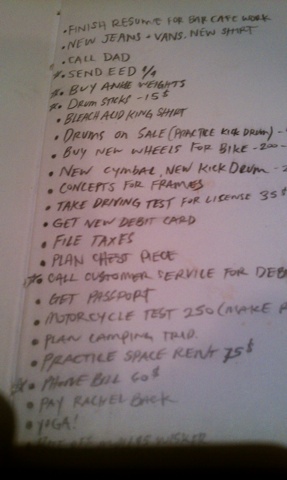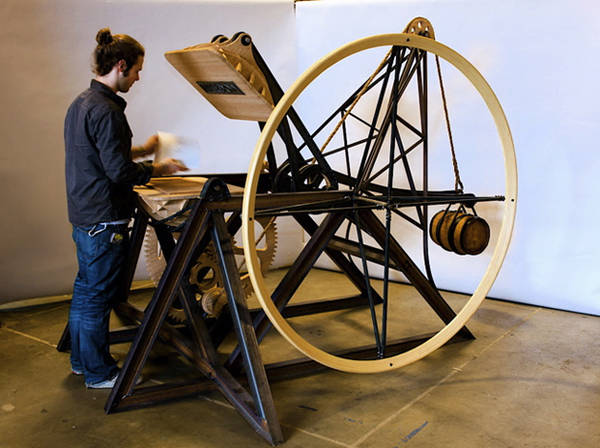The Latest from Boing Boing |  |
- Ad agency to radicals: "We own radical media(TM)"
- 3D printed Strandbeests for sale
- Facebook celebrates royal wedding by nuking 50 protest groups
- Pocket Fresnel Lens
- Wookie the Chew: Star Wars meets Winnie-the-Pooh
- How Goldman Sachs created the food crisis
- TomTom admits police used data for speed traps
- Donald "China is raping this country" Trump's line of hideously ugly clothes are made in China
- Hipster to-do list
- Police medic wields magic wellness stick
- Stolen Camera Finder
- Friday Freak-Out: The Rolling Stones' "2,000 Light Years From Home" (1967)
- Jay Rosen: What I Think I Know About Journalism
- Scratch-built "freedom press"
- Space Shuttle Endeavour STS-134 launch: snapshots from media camp
- Giddy delight at technological progress
- Space Shuttle Endeavour STS-134 launch: BB liveblog on-site, SpaceFlightNow webcast with Miles O'Brien
- Untouchable blood-camera goes to Africa for HIV portrait series
- Poop into power
- Great Moments in Pedantry: Parsing the language of porn
- Will SETI close? No, but ...
- That's what she said
- Animal-sex Friday
- The vitamin rebound effect
- HOWTO quilt a 3D Mad Tea Party set
- Low-energy astrophysics: How scientists are trying to save the Earth
- Kid has right idea about royal wedding
- Online activism works: Canada delayed US-style copyright bill in fear of activist campaign
- That's Incredible! and the yogi in the box
- Most hackable Android phones
| Ad agency to radicals: "We own radical media(TM)" Posted: 30 Apr 2011 05:14 AM PDT Jim from the Open Rights Group sez, "Activists in the UK organising a 'Radical media conference' have been told by ad agency @radicalmedia that they cannot organise a 'radical media' conference. The agency claims trademark infringement. As the activists say, 'We Make Radical Media, You Make Adverts'." |
| 3D printed Strandbeests for sale Posted: 29 Apr 2011 11:06 PM PDT I've written here before about Theo Jansen's marvellous walking mechanical Strandbeests (and the glorious hamster-powered version). Now Jansen's set up shop on Shapeways, the 3D printing place, and he's selling 3D printed versions of the eerie walkers for $105. Designing the Beests this way proved quite the challenge. They consist of at least 76 separate moving interlocking parts. Multiple prototypes were used to come to the first viable solution, "Animaris Geneticus Parvus" #5. But the evolution process continues with evolutions #6 with lightweight bone structure and #7 with pointy feet. |
| Facebook celebrates royal wedding by nuking 50 protest groups Posted: 29 Apr 2011 11:16 PM PDT What better way to honor a royal wedding than to crack down on free speech? Facebook celebrated the William and Kate wedding by nuking 50 groups that were created to protest the ongoing sweetheart deal in the UK for bankers and companies that get away with paying hardly any tax, and the cuts to services for tax-paying normal people that result from these posh tax-cheats. Facebook is not suited to the purpose of organizing political causes. It may be an easy place to mobilize people, but between it capricious management and the ease of mining it for social graphs, it is an authoritarian secret policeman's best friend and a censor's bosom buddy. FACEBOOK PAGES THAT HAVE BEEN DELETED IN THE LAST 12 HOURS: Of course, it wasn't just Facebook. London's cops were out in force, ensuring that pensioners were prevented from staging harmless street theatre that mocked the royal family. Political Facebook Groups Deleted On Royal Wedding Day (Thanks, Maggie and Ross!) |
| Posted: 29 Apr 2011 11:26 AM PDT  I'm a maintenance electrician and sometimes need to read tiny serial numbers in dark dirty places, or the color code of a resistor or some other value or rating that is difficult to accurately read with the naked eye, and for the past six months I have found that this wallet lens to be the perfect solution. Outside of magnifying small text, I have even used this to start a fire. The pocket Fresnel makes a brilliant addition to my kit of tools at my job but also is a useful survival tool when I'm outdoors. It fits in my wallet which I'm never without. Even when my kids play with my keys and I can't find them afterwards (or use the tools on my keyring) I know I've still got one tool tucked away. Best part of this lightweight super practical EDC? It's super cheap! I got mine in a 6-pack from Lee Valley, but you can get similar ones elsewhere online. --John Love Wallet Fresnel Lens $2 Don't forget to comment over at Cool Tools. And remember to submit a tool! I'm a maintenance electrician and sometimes need to read tiny serial numbers in dark dirty places, or the color code of a resistor or some other value or rating that is difficult to accurately read with the naked eye, and for the past six months I have found that this wallet lens to be the perfect solution. Outside of magnifying small text, I have even used this to start a fire. The pocket Fresnel makes a brilliant addition to my kit of tools at my job but also is a useful survival tool when I'm outdoors. It fits in my wallet which I'm never without. Even when my kids play with my keys and I can't find them afterwards (or use the tools on my keyring) I know I've still got one tool tucked away. Best part of this lightweight super practical EDC? It's super cheap! I got mine in a 6-pack from Lee Valley, but you can get similar ones elsewhere online. --John Love Wallet Fresnel Lens $2 Don't forget to comment over at Cool Tools. And remember to submit a tool! |
| Wookie the Chew: Star Wars meets Winnie-the-Pooh Posted: 28 Apr 2011 11:37 PM PDT  "Wookiee the Chew" is James Hance's inspired Winnie-the-Pooh/Star Wars mashup, a series of prints depicting the silly old wookiee and his pal Chrisolo Robin, "in a world where AT-AT's lose their tails and bobaberries are ripe for the picking, join the adventures of the biped of very little brain." It's for sale as a kid's book ("The House at Chew Corner") and a series of prints. Wookiee the Chew (via Neatorama) |
| How Goldman Sachs created the food crisis Posted: 29 Apr 2011 01:26 PM PDT Frederick Kaufman's piece for Foreign Policy examines how the Goldman Sachs Commodity Index (GSCI) is responsible for the increase in food prices. At least the Goldman Sachs vampires have plenty of money to buy guns to shoot starving peasants who will be trying to steal heirloom tomatoes from their manor gardens. Don't blame American appetites, rising oil prices, or genetically modified crops for rising food prices. Wall Street's at fault for the spiraling cost of food. |
| TomTom admits police used data for speed traps Posted: 29 Apr 2011 01:09 PM PDT "We never foresaw this kind of use and many of our clients are not happy about it." -- TomTom navigation device maker CEO Harold Goddijn plays dumb about selling user data to police so they can set up speed traps. |
| Donald "China is raping this country" Trump's line of hideously ugly clothes are made in China Posted: 29 Apr 2011 12:57 PM PDT  "China is raping this country," Mr. Trump said, adding that the United States has fallen short on technology and innovation. (Via Andrew Sullivan) |
| Posted: 29 Apr 2011 12:53 PM PDT  According to Mission Mission, this to-do list was found in a San Francisco bar. Click to see it larger. Mission Mission's headline is "Busy hipsters have epic to-do lists." (Thanks, Jess Hemerly!) According to Mission Mission, this to-do list was found in a San Francisco bar. Click to see it larger. Mission Mission's headline is "Busy hipsters have epic to-do lists." (Thanks, Jess Hemerly!) |
| Police medic wields magic wellness stick Posted: 29 Apr 2011 12:48 PM PDT |
| Posted: 29 Apr 2011 12:41 PM PDT  Matt Burns created this website to help you find your stolen camera. It looks on the web for other photos with the same EXIF ID. |
| Friday Freak-Out: The Rolling Stones' "2,000 Light Years From Home" (1967) Posted: 29 Apr 2011 10:50 PM PDT Friday Freak-Out: The Rolling Stones perform "2,000 Light Years From Home," from Their Satanic Majesties Request (1967). |
| Jay Rosen: What I Think I Know About Journalism Posted: 28 Apr 2011 11:31 PM PDT Jay Rosen's "What I Think I Know About Journalism" is a four-point mini-manifesto for the future of reporting and newsgathering. Rosen indicts the current notion of reporting with the "View from Nowhere" which Peter Goodman describes as "the routine of laundering my own views [by] dinging someone at some think tank to say what you want to tell the reader." Rosen also celebrates public participation in newsgathering, and decries commodity factual accounts of current events, calling instead for "narratives" that provide frame and context for the facts. What I Think I Know About Journalism (via Memex 1.1) |
| Posted: 28 Apr 2011 11:47 PM PDT  Artist Shawn HibmaCronan scratch-built this beautiful printing press for San Francisco International Airport's Terminal 2, working in steel, bamboo, oak, cork, and rope. I cut the bamboo gears with a CNC router. A few of the steel parts -- namely the counter weight and head arms, as well as the FREEDOM text -- I waterjet cut from 3D SolidWorks files. (I like SolidWorks because it lets me run the gears and get the tolerances perfect.) The steel frame is made out of 3" I-beam that I cut and welded together in my studio. I had to buy a bigger saw and a nice welder for it.The Press (Shawn HibmaCronan) |
| Space Shuttle Endeavour STS-134 launch: snapshots from media camp Posted: 29 Apr 2011 11:05 AM PDT Some iPhone snapshots by Xeni. |
| Giddy delight at technological progress Posted: 28 Apr 2011 10:32 PM PDT My Make column "Memento Mori" talks about the giddy, delightful vertigo I experience when I realize how fast and how far technology has come, and how fast it's moving: Memento Mori |
| Posted: 29 Apr 2011 10:59 AM PDT [ 1:53pm ET: ] President Obama is en route despite launch scrub, scheduled to arrive Kennedy Space Center at 2:10pm ET. We may see Air Force One overhead shortly. The president is reportedly en route to say hello to astronauts and Gabrielle Giffords. [ 1:03pm ET: ] Mike Leinbach, Shuttle Launch Director with NASA, is speaking about why the launch was called off. NASA now says Endeavour won't launch before Monday at 2:33pm EDT. My notes: A thermostat on one of the fuel lines, one of the heater units, failed. We tried to get the line to cool down, to see if thermostat would kick in, and tried other methods to activate -- but failed. We have a hard failure. There was another heater also exhibiting funny behavior. We believe we have a problem in the LCA, load control assemblies, switch box. Maybe a problem in the box, or in the line leading in to the box, or out of the box. But we didn't want to commit to flight with only one of the heaters functioning. Need to be able to heat the fuel [Ed. note: fuel can become very cold in space, you don't want your fuel freezing]. Probably tomorrow afternoon they'll get hands on the assembly. Once we can get in to the avionics bay where the LCA exists, we can do troubleshooting, see if we need to change out that box. We've declared a minimum of 72 hours. Today the orbiter's not ready to fly. We will not fly before we're ready. [12:52pm ET] NASA: launch may be scrubbed for at least 72 hours. [12:30pm ET] Steven Young from SpaceFlightNow explains what we know about why Endeavour's launch today was scrubbed. Short version: Not the weather, but reportedly because of a problem with one of the orbiter's Auxillary Power Units. Steven explains that there are three of these on the shuttle, to provide power for hydraulic system: during launch, they are a crucial element. They're started up about 5 minutes before launch, and they sound like giant steam engines; they're run until the shuttle reaches orbit, then they shut down. The day before launch, they fire up one of them to see if it's still working, and right before launch, they fire up one again. The rules, Steven explains, are that you want all three to be working. Two are enough to fly the shuttle normally. We don't know exactly what the problem was yet, but whatever it is, it's serious enough to cause the launch to be called off. NASA is telling us that the delay will be more than 48 hours. [ 12:18pm ET ]: Space shuttle Endeavour's launch has been scrubbed due to a problem with one of the orbiter's Auxillary Power Units. The launch will not take place at 3:47pm ET today as planned. Will post an update when we know the next launch window, but [12:17pm ET] Something unusual just happened. The crew normally heads to the launch pad, but this time they stopped at Launch Control Center (LCC) to drop off officials who were with them but aren't going to the launchpad. They pulled into the LCC entrance, went into parking lot (normally they just stop on the road outside), then made a U-turn. This may mean the launch is scrubbed.
[11:52am ET] We're seeing a cavalcade of tweeters walking out of the NASA Tweetup tent, heading off to greet the STS-134 astronauts. Pretty cool to see NASA exploring new ways to connect with people through Twitter and the like. Follow the Tweetup with the hashtag #nasatweetup. [11:41am ET] I asked this last night over Twitter, and I'll ask you good folk here: What do atheists say when they want to wish someone (or someshuttle) a good flight? "Sciencespeed"? Your thoughts in the comments, please. [11:34am ET] Today's scheduled launch is the penultimate launch for NASA's shuttle program; walking around KSC today, I'm hearing much nostalgia in snippets of conversations among journalists and NASA folk. As you drive around the towns surrounding Cape Canaveral, signs on local businesses—pizza parlors, strip clubs, churches—are all wishing "Godspeed Endeavour." What will happen to these communities, the countless mom and pop enterprises that depend on space industry and concomitant tourism? What happens to these thousands of space workers when the shuttle program ends? Some will be swooped up by private space industry, but how many will, say, SpaceX employ? Much talk of 15% or greater unemployment, property values plummeting, and an ambient sense of the rug being pulled out from under a place that calls itself the Space Coast, a place with a glamorous history during the Apollo years. Those years here are over. [11:30am ET] Thanks for tuning in to Boing Boing's royal wedding coverage: the marriage of a spacecraft with her sky.
[11:06am ET] The weather is the story out here today, and specifically: they'll be watching the wind. Gusts are so forceful out here that my Mac Air just blew right off the table and hit the ground when I stepped away for a moment. More importantly: will the wind affect the launch? Miles just spoke to the chief weather officer for NASA. 15 knots is the maximum threshold NASA will be allow, and some forecasts are calling for 18 knots. Last night, there were dramatic lightning storms and menacing clouds around KSC; the last of the storm bands from the powerful series of fronts that spawned devastating tornadoes throughout the south.
|
| Untouchable blood-camera goes to Africa for HIV portrait series Posted: 28 Apr 2011 10:24 PM PDT Wayne Martin Belger created the blood camera, which incorporates HIV-infected blood that acts as a red filter for portraits of HIV+ people. Now he's taking the project, which is called "Untouchable," to Africa: Bloodworks: Africa (Thanks, Wayne!) |
| Posted: 29 Apr 2011 09:06 AM PDT "If you look at fecal matter, what is it? It's carbon, hydrogen, oxygen and minerals -it's a great source of stuff for doing this." — Ian Gates, associate professor in chemical engineering at the University of Calgary. He's working on a method to turn human poop into a source of renewable energy. (Submitterated by hughadam) |
| Great Moments in Pedantry: Parsing the language of porn Posted: 29 Apr 2011 09:02 AM PDT  In a post that would be horribly NSFW were it not all just a block of text, linguist Arnold Zwicky blogs about how the vagaries of English allow you to interpret the same line from a gay porn in multiple ways.
From there, the post rises to a level of technical language analysis that almost, *almost* distracts from the fact that we're talking about the use of language in a porn that seems to be targeted at Brad-fetishists. Submitterated by Sam Image: Some rights reserved by johntrainor |
| Posted: 29 Apr 2011 08:28 AM PDT The good news: It doesn't look like SETI Institute itself is going to shut down for lack of funds. The bad news: Budget cuts do mean SETI might have to mothball its Allen Telescope Array, which searches the far off corners of the Universe for signs of extraterrestrial life. SETI had hoped to use the Array to scan the "Earth-like" planets identified by the Kepler space observatory. But, to do that, they need to raise $5 million. (Submitterated by IanWalker) |
| Posted: 29 Apr 2011 09:21 AM PDT Good news, everyone! They've finally programmed a computer capable of getting "That's what she said" jokes! It's called Double Entendre via Noun Transfer, or DEviaNT. (Via Tom Raftery) |
| Posted: 29 Apr 2011 08:04 AM PDT It's Friday, and you know what that means. Yes, blogger Scicurious (who brought us the whale threesome) has another post about animal sex research. This time, it's about chicken sperm. Specifically, whether roosters alter the quality of their sperm depending on how many other roosters they think have been, uh, laying with their hen—and what social status the hen, herself, has.
And the result? Well, you'll have to go read it. There are graphs that are integral to the story, and I don't want to spoil it. Suffice to say, chicken sperm is a lot more interesting than I would have previously guessed. Image: Some rights reserved by quinn.anya |
| Posted: 29 Apr 2011 07:34 AM PDT I've seen a lot of discussion over the past few years about whether or not taking vitamin pills actually produces any health benefits. Several studies have shown that vitamin-takers are no more healthy than non-vitamin takers. Now, a new study might hold a clue to why that's the case. Turns out, people who take vitamins make less-healthy choices in their daily lives. |
| HOWTO quilt a 3D Mad Tea Party set Posted: 28 Apr 2011 10:27 PM PDT  This Mad Tea Party tea-set was painstakingly quilted in 3D by Instructables user Technoplastique who documented the whole process in a great (if somewhat daunting) HOWTO: This tea set is made with quilting done in a dimensional way. It's a set of 4 teacups, 4 saucers and a teapot. This version is made with a striped fabric so that each teacup has a different design, perfect for a mad tea party. The set is entirely hand sewn, so it's a super project for keeping your hands busy in front of the tv.Quilted Mad Tea Party Set (Thanks, Christy!) |
| Low-energy astrophysics: How scientists are trying to save the Earth Posted: 29 Apr 2011 07:12 AM PDT  Listen to the scientists. That's what we say. When lots of different scientists, working separately, are turning up evidence that the Earth is getting warmer and human activities are to blame, then we should heed their warnings. Scientists, from many different disciplines, say that their research shows we should be concerned about climate change. If we want to reduce our risk, we'll have to start using less fossil fuels. That's a big shift in the way the world thinks about energy. It's bound to change our lives—and we may not necessarily like all the changes. And that fact begs a question: Do the scientists who sound the alarm on climate change have a responsibility to take the lead on energy change? Phil Marshall thinks so. He's an astrophysicist. That may not be a field of science you immediately associate with the study of climate change, but there's actually a surprisingly strong connection. Astrophysicists know a lot about planetary atmospheres. From their work, we've learned more about the greenhouse effect—the way higher carbon dioxide concentrations in an atmosphere make a planet warmer. In 2004, the American Astronomical Society called for policy makers to base their decisions on the weight of scientific evidence. Climate change is real, they said, and politicians need to recognize that fact. But astrophysicists also use a lot of energy. Like many scientists, they rely on energy-intensive technologies for gathering data. But, for astronomers, using that technology often means traveling halfway around the world on a jet plane, burning fuel all along the way. To meet all our energy needs, Americans use the equivalent of roughly 250 kilowatt-hours of electricity per day, per person. But if that American is an astrophysicist, they have to add another 133 kilowatt-hours per day to their tab. That's why, in 2009, Marshall spearheaded the writing of a manifesto. Low Energy Astrophysics—a pun on "high energy astrophysics", which is the study of things like supernovae and black holes—was a white paper, co-authored by 30 astrophysicists. The goal: Get scientists to look at their own energy use, and then convince them to set an example for other people to follow. "How can we ask people to fly less if we ourselves are doing lots of flying in the course of our work? How can we ask people to turn their thermostats down and put on sweaters if we are using whole towns' worth of electricity colliding particles together?", he says. "We have to explain the numbers to people, but then we have do everything we can to clean up our acts—just like we are asking them to." It's important to clarify one thing: Astrophysicists use a lot of energy as individuals, but astrophysics is not a major contributor to America's overall energy use. Collectively, we as Americans use so much energy that this one profession—energy-intensive as it is—barely registers. Each year, Americans consume 98 quadrillion British Thermal Units of energy. That amount of energy is enough to boil away the Great Salt Lake into a dry plain—twice. Phil Marshall and his co-authors estimate that astronomy represents only about .001% of that energy use.* This isn't about reining in a science that's set to doom us all. Instead, when Marshall and his cohorts ask other astrophysicists to use less energy, they're making the argument that scientists need to set an example. Significantly reducing the amount of energy Americans use is going to take some large-scale cultural change. And Marshall thinks scientists can lead that charge. In the Low-Energy Astrophysics manifesto, he and the other 29 signers asked scientists in their field to start by making research infrastructure more energy-efficient, cutting back on the number of airplane flights they take, and—most importantly—making sure people notice when they do those things. That last bit really is a big deal. Obviously, if you're hoping to change the way Americans live, you probably ought to make sure they know what you're up to. But, even within the astrophysics community, communication matters. The Low-Energy Astrophysics manifesto didn't really point out any mind-blowing discoveries. In fact, astrophysicists all over the world were already quietly plugging away at reducing their own carbon footprints. Trouble was, few of them were aware of each other. "What we found is that there's a lot of people that are doing a lot on their own, at home, in communities, but we're all working independently," says Bernadette Rodgers, Head of Gemini South Science Operations at the Gemini Observatory. In fact, until Low-Energy Astrophysics was published, Rodgers was one of those disconnected do-gooders. On the Ground and In the Sky In 2008, Rodgers was part of a group led by Peter McEvoy, Gemini facilities manager, which launched a campaign to make the Gemini Observatory—actually two facilities, one in Chile and the other in Hawaii—more energy efficient. Pooling ideas from Gemini staff, they started making changes, both to the buildings and equipment, and to the way people worked. For instance, a lot of an observatory's energy use goes to air conditioning. There's a couple of reasons for that. First, like any facility that's home to a large collection of computers, observatories have to counteract all the heat that's thrown off by humming PCs, laptops, and servers. If you don't cool the building, that heat can damage the very machines that create it. But observatories also have special cooling problems. High up in the dome, every telescope has its own, personal cooling system. "You want the mirror and support structures to be in thermal equilibrium with the outside air while you're observing," Rodgers says. "It improves the quality of the image. You know how, on a hot day when you look down a road, the image kind of shimmers? The quality of an image that you see, the sharpness, depends on disturbance in the air, and that relates to temperature variations." To reduce the amount of energy it uses to keep things cool, Gemini bought more-energy-efficient air conditioners. But the facility managers also changed the way they cooled the telescopes. After reviewing the temperatures in the dome, they figured out that they were actually keeping the telescopes too cold. They found that adjusting the thermostat to the temperature at the start of the previous night, rather than the lowest temperature during the night, reduced the cooling but still kept the telescope cold enough to be ready for observations. Let the telescopes get a little warmer, and you save some energy. All told, since 2007, the Gemini facility in Chile has reduced its electricity use by 25%, while the one in Hawaii has cut electricity by 31%. But the biggest astrophysics energy hog is air travel. That's especially true at Gemini, where scientists and support staff often travel back and forth between Chile and Hawaii several times a year. And it's true for individual astrophysicists, as well. Astrophysics is a small, and particularly international, community, with researchers from all over the world working together and sharing expensive pieces of equipment. Many of the astrophysicists I talked to told me that one of the things that had originally drawn them to that field of science was the opportunity for travel. Study the stars, see the world. Now, many of them are making the emotionally difficult decision to spend more time on the ground. At Gemini, for instance, they were able to reduce air travel by 23%, just by raising awareness and getting people to think about whether trips were really necessary. Another way to do reduce air travel is through virtual astronomy. Traditionally, an astrophysicist had to fly halfway around the world and physically sit in the telescope herself, making observations and studying the stars. Today, that story is romantic, but not strictly necessary. Some observatories, including Gemini, operate in "queue mode"—astrophysicists put in research requests and observatory staff gather the actual information, deciding whose research gets done when based on a complicated algorithm that factors in both importance of the research, and weather conditions on a given night. Another option is to use the telescope in remote mode. Here, an astrophysicist still gets assigned a night, or block of nights, when the telescope is dedicated solely to her. But, instead of traveling to the telescope, she links in and controls it via the Internet. Meanwhile, on-site observatory staff are available to help make adjustments or solve emergency breakdowns. Both these systems have flaws. For instance, if your research isn't deemed important enough, you might wait forever and never get any data back from a queue-mode telescope. But there's no doubt that they cut down on hemisphere-hopping flights. Small Potatoes on a Big Buffet The energy changes made by people like Phil Marshall and the staff at the Gemini Observatory are good. But, until recently, they kind of happened inside a vacuum. The scientists weren't aware of each other, and few outsiders knew what was going on, either. That lack of awareness was so complete that, to a certain extent, it actually made all the effort somewhat irrelevant. On a personal level, or an organizational level, what the astrophysicists were doing did matter—they were reducing their own carbon footprints. But those personal changes didn't do much to alter the course of climate change. For instance, in 2009, John Lacy, a professor at the University of Texas, dropped out of SOFIA—a project aimed at building an airborne telescope that would be flown around the skies on a 747. SOFIA could get astrophysicists a clearer view of space than they could capture on the ground, without some of the size constraints of a space-based telescope. Lacy had designed one of the instruments that was a part of the SOFIA telescope. But he eventually decided that he didn't want to be a part of a project that would—on its own—double the carbon footprint of the entire field of astrophysics. He dropped out, but SOFIA went on, unfazed. "The instrument I was working on is still around. My getting out of SOFIA didn't really change much," Lacy says. " If I could convince astronomers to cancel SOFIA entirely, I would. I've wondered whether being more vocal would be more productive." That, astrophysicists say, is the value of the Low-Energy Astrophysics manifesto. Since the paper was published, it's helped forge connections between the scientists who were, previously, working alone. Phil Marshall met Bernadette Rodgers and other environmentally-minded researchers. Rodgers discovered organizations like the Union of Concerned Scientists. And Rodgers, Marshall, Lacy and 3 other astronomers organized the first professional astronomy "green" meeting as part of the American Astronomical Society bi-annual meeting in January 2010. Since then another astrophysicist, James Lowenthal, Associate Professor of Astronomy at Smith College, has started a sustainability committee as part of the American Astronomical Society. It's this last development, still in its infancy, that the astronomers hope will help them turn personal decisions into public good. Through the AAS committee, the astrophysicists I spoke with hope to make some big statements about energy efficiency and conservation. Their first goal: Convince the AAS, as a whole, to make it easier for its members to attend conferences virtually—or, better yet, encourage them to make whole meetings virtual-only. Astrophysics, as a field, has a big public profile. (Admit it, this article was instantly more appealing because it involved people who study outer-space.) Lowenthal thinks his committee can combine astrophysics' energy-saving efforts with astrophysics' instant publicity appeal and end up with something that really inspires large numbers of Americans to use less fossil fuels. But first this relatively small—and relatively young—group has to convince the rest of their peers to sign on. Neither Marshall, nor Rogers, nor Lacy, nor Lowenthal are sure how astrophysics, as a whole, will react to what they're trying to do. So far, nobody has been hostile to the goals of the AAS Sustainability Committee, but open hostility isn't the only potential roadblock. The AAS might simply ignore, or water down the Sustainability Committee's recommendations. That's especially a possibility when it comes to reducing air time. Lowenthal suspects that there would be pushback if the Committee actually suggested shutting down SOFIA, for instance. And he has doubts about whether other committees would be willing to have their meetings over Skype, the way the Sustainability Committee has done. But it's worth trying, he says. If they do this right, the actions the Sustainability Committee takes can influence other astrophysicists, whose actions can influence the general public. "People's minds aren't made up by receiving information, but by the perception that everybody else is doing it. Individual changes matter by setting the norm and sending the message that this is part of the public discussion," Lowenthal says. "On my own, cutting a couple of flights will save as much as several tons of carbon dioxide, but there are few astronomers—only 6000 or 7000 in the US—and we're small potatoes. The multiplier effect comes from our having relatively high profile status." For more information: Check out the Low-Energy Astrophysics wiki. *In contrast, even something like the Department of Defense only accounts for roughly 1% of American energy use. Think about that. We use so much energy in this country, that we could shut down the entire military, and barely make a dent. This is a collective problem, that has to be solved collectively. If we try to chip away at our own little bit, one person at a time, we'll never get there. Image: Some rights reserved by Clinton Steeds |
| Kid has right idea about royal wedding Posted: 29 Apr 2011 07:05 AM PDT |
| Online activism works: Canada delayed US-style copyright bill in fear of activist campaign Posted: 28 Apr 2011 10:17 PM PDT Michael Geist sez, "A new Wikileaks cable confirms that the Canadian Conservative government delayed introducing copyright legislation in early 2008 due to public opposition. The delay - which followed the decision in December 2007 to hold off introducing a bill after it was placed on the order paper (and the Fair Copyright for Canada Facebook group took off) - lasted until June 2008. The U.S. cable notes confirmation came directly from then-Industry Minister Jim Prentice, who told U.S. Ambassador David Wilkins that cabinet colleagues and Conservative MPs were worried about the electoral implications of copyright reform." From December 2007 to mid-February, senior GOC officials and well-informed private sector contacts assured the Embassy that legislative calendar concerns were delaying the copyright bill's introduction into Parliament. Our contacts downplayed the small - but increasingly vocal - public opposition to copyright reform led by University of Ottawa law professor Dr. Michael Geist. On February 25, however, Industry Minister Prentice (please protect) admitted to the Ambassador that some Cabinet members and Conservative Members of Parliament - including MPs who won their ridings by slim margins - opposed tabling the copyright bill now because it might be used against them in the next federal election. Prentice said the copyright bill had become a "political" issue. He also indicated that elevating Canada to the Special 301 Priority Watch List would make the issue more difficult and would not be received well.The bill died, and all its successors have died too. Wikileaks Cable Confirms Public Pressure Forced Delay of Canadian Copyright Bill in 2008 |
| That's Incredible! and the yogi in the box Posted: 28 Apr 2011 09:25 PM PDT Yesterday, my post about John Moschitta, Jr.'s 1981 appearance on That's Incredible! kindled memories among commenters of Yogi "Kudu" who famously contorted himself into a small plexiglass box on the show. For many years I too wondered what became of that fellow. Turns out, most of us have been spelling his name wrong, making it difficult to find any useful information on Google. The magical man is actually Yogi Coudoux and he is alive, well, and living in France where he runs the Centre Yogi Coudoux and still performs amazing feats of the body and mind like "La Tarentule," above. In 2006, he even published a book in the USA, titled Breathing Life: Yogi Coudoux's Pranayama Techniques. Nearly thirty years after That's Incredible!, I wonder if Yogi Coudoux can still squeeze himself into that tiny box. |
| Posted: 29 Apr 2011 06:12 AM PDT Mike Isaac rounds up the most easily-hacked Android smartphones. Spoiler: just get the Galaxy S if you need to root an Android right now. Otherwise, wait for the next one from Sony, whose cellphone department is notably hacker-friendly, in contrast to its hacker-suing department, or, indeed, its department of getting hacked. [Wired] |
| You are subscribed to email updates from Boing Boing To stop receiving these emails, you may unsubscribe now. | Email delivery powered by Google |
| Google Inc., 20 West Kinzie, Chicago IL USA 60610 | |



 The more people involved in flying the airplane, or moving the surgeon's scalpel during a brain operation, the worse off we are. But this is not true in journalism. It benefits from participation, as with Investigate your MP's expenses, also called crowd sourcing, or this invitation from the Los Angeles Times: share public documents. A far simpler example is sources. If sources won't participate, there often is no story. Witnesses contribute when they pull out their cameras and record what is happening in front of them. The news system is stronger for it...
The more people involved in flying the airplane, or moving the surgeon's scalpel during a brain operation, the worse off we are. But this is not true in journalism. It benefits from participation, as with Investigate your MP's expenses, also called crowd sourcing, or this invitation from the Los Angeles Times: share public documents. A far simpler example is sources. If sources won't participate, there often is no story. Witnesses contribute when they pull out their cameras and record what is happening in front of them. The news system is stronger for it...  I'm often puzzled by how satisfying older technology is. What a treat it is to muscle around an ancient teletype, feeding it new-old paper-tape or rolls of industrial paper with the weight of a bygone era. What pleasure I take from the length of piano roll I've hung like a banner from a high place in every office I've had since 2000.
I'm often puzzled by how satisfying older technology is. What a treat it is to muscle around an ancient teletype, feeding it new-old paper-tape or rolls of industrial paper with the weight of a bygone era. What pleasure I take from the length of piano roll I've hung like a banner from a high place in every office I've had since 2000. 
 I'm taking the untouchable to Sierra Leona, Liberia, Uganda, Ethiopia, Calcutta and 5 locations in Cambodia to do portraits of people living with HIV. I'm working with a major international HIV Health organization to make it all happen and they are really excited about the possibility of this project creating a new view of the global HIV community. So far, I've photographed about 60 people all over the US. With the Africa/Asia photos it will give a world contrast on how your geo location makes all the difference in your well-being and how major pharmaceutical profits need are at the heart of life and death.
I'm taking the untouchable to Sierra Leona, Liberia, Uganda, Ethiopia, Calcutta and 5 locations in Cambodia to do portraits of people living with HIV. I'm working with a major international HIV Health organization to make it all happen and they are really excited about the possibility of this project creating a new view of the global HIV community. So far, I've photographed about 60 people all over the US. With the Africa/Asia photos it will give a world contrast on how your geo location makes all the difference in your well-being and how major pharmaceutical profits need are at the heart of life and death. 
 Grace van Cutsem, 3, has clearly had enough. Photo: Reuters/Darren Staples.
Grace van Cutsem, 3, has clearly had enough. Photo: Reuters/Darren Staples.
No comments:
Post a Comment